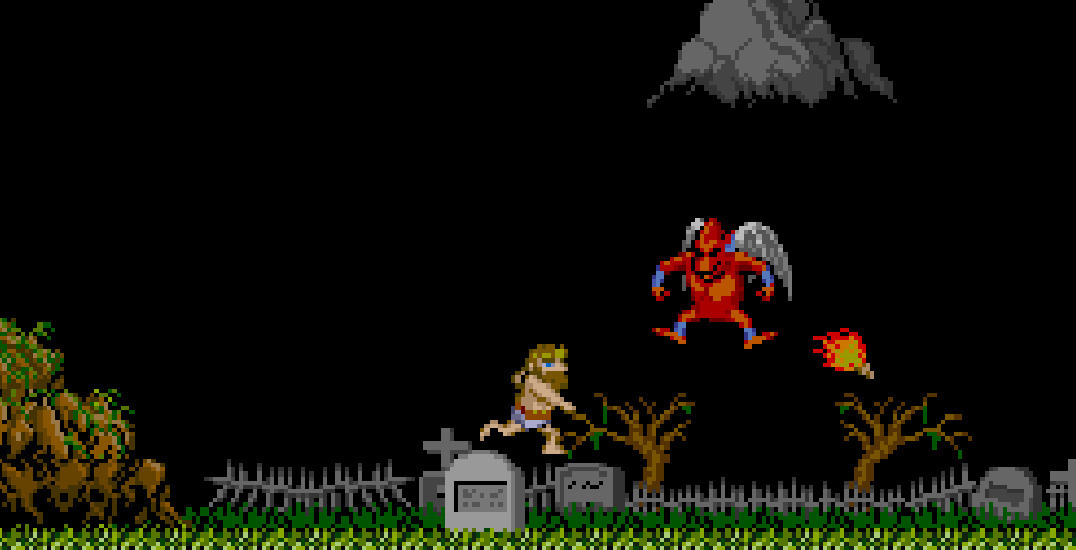
With the release of Sekiro we have been having the same old conversation about difficult games. Difficulty in games is a form of gatekeeping, they say. An unnecessary quirk of game design which ought to be abandoned. Difficult games are disrespectful, even, and good developers would add an easy mode.
And I disagree. I don’t believe some games being difficult is disrespectful, elitist or wrong but simply necessary.
DIFFICULTY AS MEANS TO DELIVER A MESSAGE
One of the most common reasons why some games need to be difficult is to convey a certain idea or theme. A high level of difficulty can produce, for example, a sense of danger or ruthless competition. It raises the stakes and forces the player to be more careful with the decisions taken over the course of the game.

The trickery of Ghosts’n Goblins is a good example. In that game you fight against the devil and overconfidence will get you killed. Enemies dodge your attacks, attack from both air and land and patience is the most necessary skill. The high difficulty of the game drives its comedic horror theme and wouldn’t work as well without it.
Many other games work in a similar way. Both the Sisyphean struggle of Dark Souls and the hopelessness of R-Type are also driven by their difficulty. Even Kirby’s Adventure, which sits at the other side of the spectrum, derives its sense of whimsy from it. But, if there’s a game that shows how important difficulty can be to a message, it’s Ben Madison’s The White Tribe.
The White Tribe is a game about the Rhodesian Civil War. In it you are placed in the shoes of the government of the country and try to convince its racist parliament to transition to an equal state based on majority rule. With rebel forces attacking from neighbour countries, the precarious state of the republic’s treasury and the rising tide of discontent, it’s a fiendishly difficult game. And it couldn’t be any other way.

The White Tribe shows how critical the situation was through its mechanics. It’s difficult because the situation in real life was. Were we to make it easier, we would also be portraying racism, war and integration as being easier. The game would no longer reflect its subject matter and, hence, wouldn’t be able to say anything meaningful about it.
DIFFICULTY IS INHERENT TO GAME DESIGN
Most games, however, are not difficult just for thematic reasons but simply because their design causes them to be. That is, something in their mechanics, scenarios or principles of play has an inherent amount of difficulty without which they wouldn’t be able to exist.
Take puzzles as an example. By definition, a puzzle is a problem or situation we cannot easily solve. They are inherently difficult elements. And if we want to include them in a game, perhaps because they are interesting or fun, we must also accept the difficulty that comes with them.
I believe this point is important because gamers tend to see difficulty as a barrier to their enjoyment. “We cannot access the fun”, some say, “because the difficulty gets in the way”. Difficulty “locks them out” of seeing more content or partaking in the full experience, as if how the game was supposed to work, and its difficulty were separate from each other.

There’s a tendency in gaming to confuse completing a game with playing it. To see the point of the game as reaching the goal instead of the steps taken to get there. Difficult games do not lock out people out of their enjoyment any more than Turkish food locks out the flavour behind the spiciness. The difficulty of a game and its play experience are both part of one another.
DIFFICULTY SETTINGS
One might wonder where that leaves difficulty settings. Are they a mistake, then? Should all games have just one level of difficulty? I don’t think so. I believe settings can be a useful tool to adjust the level of challenge of a game to individual players. The problems with them are not theorical, but practical.
Let’s be honest, difficulty settings tend to be terrible. Most of the time, all they do is change up some numbers or turn enemies into bullet sponges. They are not well-made, much less throughly playtested and, generally speaking, are a waste of the player’s time. As far as development goes, it’s clear that good difficulty settings are way down the priority list.
Either way, since difficulty and design are correlated, selectable settings tend work best when they don’t require large changes to be made. For example, they can work well when the difficulty is rooted on how strong your rivals are, like in Chess or Sid Meier’s Civilization. Facing players against better or worse opponents doesn’t affect balance, nor the game’s mechanics, which allows the nature of the game to be maintained.

On the other hand, difficulty settings do not work as well for games based on level design. Here, any attempt to change the difficulty will require extensive reconstruction of the whole game down to individual enemies and puzzles. Some genres, like shmups or beat’em ups, are so reliant on this aspect that difficulty levels may very well be whole new games as far as design is concerned.
Sadly, I don’t think these issues have been given the weight they deserve in this debate. Dave Thier, for example, argues that “all you need to do is turn up the damage the player does and turn down the damage the enemies do”. And I believe that’s a textbook example of bad game design. After all, what use is an easy mode if what’s good about the game is lost in the process?
It’s for this reason that I cannot join writers like Kuchera or Keplek in their praise of invulnerability modes like those found in Fire Emblem Fates and Celeste. I think these modes, which take away all value found in gameplay, are artistically bankrupt and, hence, cannot accommodate any kind of player, no matter how easy or difficult they are.
DISABILITY AND DIFFICULTY
I do not like the way disability has been covered in this debate. I’m not fond of how it has been reduced to cover only dexterity problems or how it has been listed alongside “not having enough time” and “I paid for the game” in lists of grievances. Above all, I hate how gamers are so willing to use the topic when it’s convenient yet are so quick to forget otherwise.

Regardless, I find the focus on difficulty to be misguided. While some connections between difficulty and accessibility can be made, I believe they are not as interlinked as they might appear at first glance.
The most common barriers to accessibility are unrelated to difficulty. In fact, they are not related to game design at all. Lack of subtitles, no colourblind mode and no button remapping are some of the biggest issues faced by gamers with disabilities and, yet, affect games of all kinds.
Even then, the relationship between design, accessibility and difficulty is fuzzy. Many of the mechanics we regard as easy, like Quick-Time Events aren’t great from an accessibility standpoint. The joystick twirling and input spamming of God of War (2018), for example, make the game very easy but also render it unusable for those with dexterity problems. On the other hand, there’s a sizable contingent of disabled gamers who enjoy difficult retro games because they require few buttons to play.
We must keep in mind that difficulty modes don’t address fundamental accessibility barriers. Making a game easier won’t make it no longer require literacy, dexterity or certain cognitive capabilities. An easy mode can only adjust the challenge of a game to align more closely to individual players. The presence of difficulty modes in Beatmania IIDX, for example, hasn’t made the game any more playable for those who struggle with repetitive button presses.

Developers should seek to eliminate unnecessary barriers but do so elegantly. Blunt, poorly implemented accessibility options not only fail to address the problem but diminish the very experience players are trying to access. Gamers with disabilities care about the quality of the games they play as much as anyone else.
Still, the lack of accessibility features remains a disgrace for the medium. It’s undeniable that games could do much better in this regard and that it would require few, if any, sacrifices to be made to their design. It is shameful that game companies are forced to comply with PEGI and the ESRB but not with any sort of disability legislation. That ought to change.



